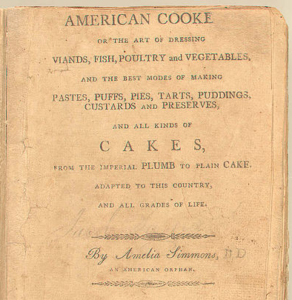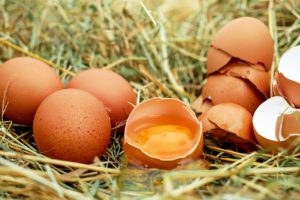The “American Cookery” cookbook is just 50 pages long. Some of the recipes are only a few lines. Despite its modesty, this book published in 1796 is one of the most important texts in American history. It’s the first cookbook published by an American in America. Who was this American?
Amelia Simmons is a mystery. She identifies herself as an orphan and as “a woman of modest means,” which implies she wasn’t well-educated. She most likely worked for her income, and based on some of the recipes, it appears she was from New England. Some scholars place her in the Hudson River Valley, however, which includes the cities of New York, Salem, and Albany. This is based on her use of Dutch words and the fact that later editions of the cookbook were published from this area, and not New England. We’ll likely never know for sure.

The original cover of “American Cookery”
What we do know is how important “American Cookery” is as a historic document. Until this book, all cookbooks were from England, and used English terms and ingredients. Amelia Simmons, however, embraced uniquely-American phrases like calling for “shortening” instead of “fat,” and saying “cookies” instead of “biscuits.” She also focused a lot on cornmeal, which was an American staple. The “Johnny Cakes” recipe has the distinction of being the first-ever printed recipe to use cornmeal. Also a first: a recipe for turkey served with cranberries.
In England, those recipes would have been very strange. They used oats, not cornmeal. The English and Europeans in general, however, did like Simmons’ use of leavening agents. These were the first baking powders, and were much more convenient than needing to add yeast or beating air into dough.
“American Cookery” had several printings because it was so popular. However, in the second edition, the publisher included a “market guide,” which consists of notes about ingredients and how to choose the best ones. Amelia Simmons was not pleased. In the preface to the book, she emphasized how she did not approve of the changes, and that advice on how to choose the best fruits and vegetables was insulting to her readers. She described the reasoning for the changes as “ignorance” or an “evil intention of the transcriber.”
Strong words, especially considering that the guide actually seems pretty useful. It’s definitely useful for historians, who appreciate any tidbits about how colonial America functioned. The transcriber gives advice such as choosing small onions for flavor, and large Madeira ones to bulk up recipes. There are also warnings about how food sellers will use tricks to fool buyers, such as wetting fish, warming milk in a pail by the fire and selling it as “warm from the cow,” and so on. We get descriptions of different kinds of peas, beans, and cabbages. A fun glimpse into the mind of the transcriber is also present: they didn’t like garlic, and say it’s better as medicine than food.

Get ready to use a lot of eggs when following recipes from old cookbooks like “American Cookery”
“American Cookery” was hugely popular and even pirated. In 1808, Lucy Emerson stole the entire book verbatim and only changed the title to “The New-England Cookery.” Only four copies of the original first edition remain. Curious about making a recipe from “American Cookery?” Plan to feed a crowd. One cake recipe calls for 2 pounds of butter and a whopping 15 eggs. You can get the book from Amazon for around $5.
———
The food culture in the American colonies was a blend of cuisine from Europe. However, the pumpkin pie is one of the few truly “American” dishes.




